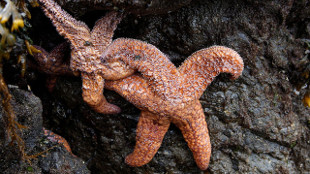
“When we inoculated them, they died within about a week to 14 days,” Cornell microbiologist Ian Hewson told Oregon Public Broadcasting’s EarthFix. “Whereas controls that had received viruses that had been destroyed by heat, did not become sick.”
Sequence analyses uncovered the densovirus, which turned out to be present in museum specimens dating back as far as 1942. Although sea star wasting disease has been observed in the past, this is the first time it has spread this widely and to such a range of species—at least 20 different taxa.
“This is probably the most extensive and devastating disease of marine invertebrates that has happened,” ecologist Bruce Menge of Oregon State University told Science. “It’s a major concern,” added Menge, who was not involved in the study.
The die-off has already led to increased populations of the sea stars’ prey, including barnacles and mussels, in many coastal areas. Researchers are continuing to examine whether factors such as increased ocean temperatures and acidification might contribute to the spread or severity of the disease.











RSS